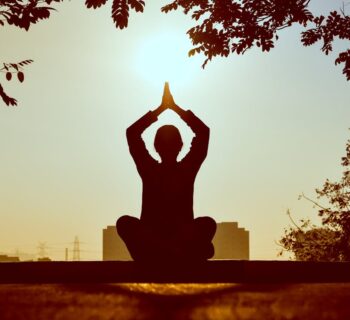Breathwork is often the unsung hero of any yoga practice, yet many students overlook its transformative potential.
Harnessing breathwork can elevate your flow, unlocking a deeper, more synchronized mind-body experience. It’s your key to evolving beyond the physical mat.
Introduction to Breathwork in Yoga
In yoga, breathwork serves as the conduit through which energy flows, relieving stress and aligning mind, body, and spirit. The powerful synergy of breath and movement transforms practice, cultivating a profound sense of peace.
In yoga, breathwork is not merely breathing exercises.
It embodies pranayama—a Sanskrit term that translates to the extension and control of breath, which is pivotal to refining one’s practice.
Through intentional breathing, practitioners can access enhanced focus and resilience, ensuring each pose is both grounded and uplifted.
Integrating breathwork into yoga connects practitioners to ancient wisdom, facilitating meditation and reflection, even as they embrace modern life’s frenetic pace.
Thus, embrace your innate power, guiding your practice towards a horizon of tranquility. Engaging in breathwork transforms your journey, ushering in clarity and presence.
What is breathwork and how does it work?
Breathwork encompasses a diverse range of controlled breathing techniques that are designed to harmonize the mind and body, fostering a deeper sense of presence and tranquility.
Through conscious manipulation of breath, one can stimulate parasympathetic nervous responses, promoting relaxation and mental clarity.
Breathwork practices can help alleviate stress, manage emotions, reduce anxiety, and boost mental focus, ultimately contributing to enhanced overall well-being.
By integrating deliberate breathing exercises into daily routines, individuals gain tools to navigate stress and cultivate resilience.
The journey of breathwork invites practitioners to explore the profound intricacies of the breath, unlocking transformative potentials at both a physiological and psychological level.
Thus, it is a testament to humanity’s innate capacity to harness inner peace. Through regular practice, individuals can expect to experience improved health, emotional balance, and a richly rewarding connection with their inner selves.
Benefits of Breathwork for Yoga Practice
By unlocking the potential of breathwork, yoga practitioners can enhance their experience and deepen their connection to each pose.
With the incorporation of breathwork into a yoga practice, individuals unlock a gateway to heightened awareness, allowing them to transcend mere physical exercise and delve into a state of meditative flow. This seamless integration nurtures a sense of unity, fostering an internal environment where tranquility and strength coexist, poised to unfold with each inhale and exhale.
Intentional breathwork cultivates a mindful presence within each yoga session. With conscious breathing, the practitioner gains access to a serene mental clarity that transforms the rush of daily existence into moments of focused serenity. Such mastery over breath lays the foundation for a deeply fulfilling, introspective yoga journey.
Breathwork elevates the overall effectiveness of yoga by enhancing endurance, flexibility, and mental resilience. This holistic approach empowers practitioners to push their limits with grace, overcoming physical and emotional barriers. Through the gentle harnessing of the breath, an inspired yoga practice emerges—a path characterized by transformative growth and an abiding sense of peace.
How do I start practicing breathwork?
Embarking on the transformative journey of breathwork can be a life-enhancing decision. This practice is a cornerstone for achieving deeper connections within your yoga flow.
Begin by setting aside a dedicated time each day, even if it’s just five minutes, to focus solely on your breath. Find a serene space, perhaps a quiet corner of your home, where interruptions are minimal, allowing your mind to ease into tranquility.
Consider starting with simple breathing exercises, such as diaphragmatic breathing or box breathing. These methods encourage mindfulness and can elevate your awareness and control over each inhale and exhale, laying a sturdy foundation for more complex techniques. Try some of the breathing exercises described later in this post.
Regular practice will cultivate a profound connection between your breath, mind, and body, enriching your yoga practice. As you become adept at these techniques, you will likely notice an increasing capacity for focus, resilience, and inner peace.
With consistency and dedication, your breathwork journey will seamlessly integrate into your daily life, profoundly enhancing your yoga flow while nurturing overall well-being.
Basic Breathwork Techniques for Beginners
For those embarking on their yoga journey, basic breathwork techniques present a gateway to deeper practice and introspection.
To commence, try the foundational practice of a diaphragmatic breath. Sitting or lying comfortably, place one hand on your abdomen and the other on your chest. Inhale deeply through the nose, letting your abdomen rise visibly. This tactile feedback helps foster a connection between breath and body, grounding your practice.
Alternatively, explore the gentle cadence of an equal breathing pattern for calming effects. Aim for even inhalations and exhalations, typically counting to four. This rhythmic balance promotes a sense of equanimity, allowing you to remain centered and calm amidst life’s turbulent currents.
Ultimately, these foundational breathwork techniques empower beginners to cultivate awareness, stamina, and tranquility through visualization. By embracing these practices, you unlock gateways to the vast potential within, shaping more profound, harmonious yoga experiences. Emerging with newfound vibrancy, these techniques instill not only enhanced yoga practice but also enriching life transformation.
Diaphragmatic Breathing Explained
Diaphragmatic breathing, often referred to as “belly breathing,” is a conscious effort to draw breath deep into the lungs. This foundational technique encourages fuller oxygen exchange, enhancing overall respiratory efficiency.
Yoga practitioners widely embrace this method to improve their physical performance. It fosters a greater connection to the body’s natural rhythms.
In practice, this technique involves deliberately engaging the diaphragm muscle. This leads to more profound inhalations and exhalations, allowing for increased oxygen intake.
This type of breathing can help reduce stress and anxiety, promoting relaxation. As the diaphragm actively engages, it can alleviate tension in the surrounding muscles.
Mastering diaphragmatic breathing unlocks a cascade of health benefits, including reduced stress and anxiety, lowered heart rate, and improved core muscle stability. As practitioners hone their technique, they find greater ease in holding poses for extended periods, thereby deepening their yoga flow.
The mastery of diaphragmatic breathing is more than a relaxing escape. Engaging breathwork fosters a profound presence, nurturing not only yoga practice effectiveness but also an enduring sense of well-being.
Ujjayi Breath for Enhanced Focus
Ujjayi breath, often called “victorious breath,” is a vital component of yoga practice. This ancient technique is known for its ability to boost concentration and enhance presence on the mat. By directing attention to the flow of breath, practitioners anchor their awareness more deeply in the present moment.
The breath is produced by slightly constricting the throat.
This creates a soft, whispering sound that echoes the rhythms of the ocean – an effect that naturally emboldens practitioners to stay attuned. With consistent practice, the ujjayi breath becomes a dynamic tool, synchronizing mind and body in harmony.
Embracing this technique not only translates into increased mental clarity but also cultivates a profound sense of calm. Studies continue to affirm the physiological benefits of ujjayi breath, identifying its role in optimizing blood pressure and encouraging a heart rate conducive to inner equilibrium. Use the ujjayi technique as your guide, harnessing deliberate breaths to unlock the mindful potency within your practice.
Nadi Shodhana for Energy Balance
Nadi Shodhana, or alternate-nostril breathing, invites balance into your practice by harmonizing energies. With its roots in ancient yogic traditions, this technique seeks to restore equilibrium, channeling vitality and focus.
As you inhale through one nostril while exhaling through the other, Nadi Shodhana fosters an unobstructed flow of energy, paving the way for rejuvenation and holistic alignment. Like a gentle breeze, it ignites clarity.
The words “Nadi” and “Shodhana” signify channels of purification, a testament to its essence of cleansing the nervous system’s pathways.
Steps for Practicing Nadi Shodhana
Begin by comfortably seating yourself in a cross-legged position, allowing your spine to remain erect and receptive.
Practicing Nadi Shodhana for just a few minutes each day can enhance mental clarity and emotional stability.
Using your right hand, gently position your thumb over the right nostril, and exhale completely through the left. Inhale deeply through the left nostril, then shift to close it, releasing the right nostril to exhale.
As you alternate nostrils—creating a rhythmic and mindful pattern of breathing—you seamlessly encourage equilibrium within your body and mind, paving a conscious path toward inner peace and centeredness.
Kapalabhati for Cleansing and Energy
Kapalabhati, often referred to as “Skull Shining Breath,” is a pivotal breathwork practice celebrated for its revitalizing effects. Harmonizing tradition with modern wellness, this technique recharges the spirit.
Incorporating Kapalabhati into your yoga repertoire can significantly enhance your practice by cultivating increased energy and mental clarity. With focused, impactful breaths, it excites the neural pathways.
In essence, Kapalabhati involves explosive exhales followed by passive inhales, engaging the diaphragm powerfully. This breathwork not only invigorates the practitioner’s body but also purges stagnant energy, facilitating an elevated state of consciousness.
To practice, assume a comfortable seated position with an erect spine. Exhale sharply through the nose with forceful abdominal contractions, allowing passive inhalation between breaths.
With consistent practice, Kapalabhati instills both a serene mind and a vibrant body, setting a dynamic foundation for further exploration in your yoga journey.
Incorporating Breathwork into Yoga Flow
Integrating breathwork into your yoga flow isn’t merely an addition; it’s a transformative shift. It anchors your mind, aligning both your physical postures and spiritual experience.
Breathwork creates a seamless connection between each movement.
Rhythmically, intentional breathing guides the transition and stabilization, enhancing asana (posture) effectiveness and mindfulness.
Utilizing breath techniques like Ujjayi to emphasize calm, focused breathwork complements the flow, supporting both energetically and mentally.
Breathwork holds the key to synchronizing body movements coherently, enabling yogis to delve deeper into their practice and withdraw from distractions. This intimate connection reveals a powerful inner resilience, showcasing progress both on the mat and in everyday life.
Ultimately, the art of breath infuses one’s practice with an essence of grace. With breathwork seamlessly woven into your yoga, you unlock pathways to profound energetic expansion.
When is the best time to practice?
Taking time to synchronize your practice with the rhythms of the day can significantly elevate your experience and results.
In the morning, your mind is clear and your body receptive, making it a beneficial period for engaging in mindfulness practices. This is when you can harness the tranquility of dawn, allowing breathwork techniques to connect deeply with your inner energy, setting a positive tone for the day ahead. The soft morning light and serene surroundings enhance concentration, making complex yoga flows more effective.
Alternatively, afternoon sessions offer the advantage of replenishing your body’s energy after the midday slump. Practice can invigorate the senses, combating fatigue and refreshing the mind. A reflective afternoon breathwork routine can soothe stress, encourage creativity, and restore balance to life’s busy pace, embodying a holistic integration of wellness.
Evening practices serve as a profound conclusion to the day, channeling accumulated stress and tension into restorative movements. Nighttime sessions allow for introspection and gentle breath focus, calming the nervous system and preparing the body for restful sleep. This is an ideal time to incorporate deep breathing exercises that guide the mind into a state of relaxation, enhancing both well-being and inner peace.
Common Mistakes in Breathwork
While engaging in breathwork techniques, students often overlook the importance of mindful breathing in enhancing their yoga practice.
One mistake is allowing breath to become shallow, hindering oxygen flow and limiting mind-body connection. For optimal results, ensure inhalations and exhalations remain full and steady.
Additionally, many practitioners rush breathing, not matching breath rhythm with movement. Aligning both can transform practice, fostering deeper focus and harmony.
Some also neglect the pause between breaths, which offers a moment of silence for reflection. This pause can enhance the synchronization of breath and movement.
Correcting these pitfalls elevates your practice, allowing breathwork to fully enrich your yoga journey.
Creating a Personal Breathwork Routine
Embarking on your journey to refine breathwork requires intention, dedication, and a curious spirit. How do you begin crafting a routine that supports the richness of your practice?
It’s not just about finding what works; it’s about recognizing the subtleties of each technique’s impact on the physical, mental, and energetic plane. Explore various breathwork methods, and notice how your energy levels respond.
Commit to consistency in practice, knowing that as your breathwork routine matures, it unlocks profound experiences with each new cycle of inhalation and exhalation. Adapt the practice to suit the demands of your day, whether it’s 3, 5, or 20 minutes of mindful inhalation, and observe transformational outcomes.
Maintaining a flexible mindset allows your breathwork practice to evolve, providing newfound clarity and sustaining your yoga flow.










